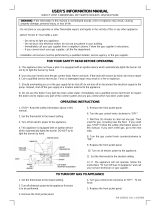
Part number 550-142-055/0411
3
GV90+ gas-fired water boiler — User’s Information Manual
STOP!! — Read before proceeding
Failure to adhere to the guidelines on this page can result
in severe personal injury, death or substantial property
damage.
Boiler service and maintenance —
• To avoid electric shock, disconnect electrical supply before
performing maintenance.
• To avoid severe burns,
allow boiler to cool before performing
maintenance.
• You must
maintain the boiler as outlined in the manual and have
the boiler started up and serviced at least annually by a
qualified service technician
to ensure boiler/system reliability.
Boiler operation —
• Do not block flow of combustion or ventilation air to boiler. This
boiler is equipped with a control which will automatically shut down
the boiler should air or vent be blocked. If vent or air blockage is
easily accessible and removable, remove it. The boiler should attempt
to restart within an hour. If blockage is not obvious or cannot be
removed, have the boiler and system checked by a qualified service
technician.
•
Should overheating occur or gas supply fail to shut off, DO NOT
turn off or disconnect electrical supply to circulator. Instead, shut off
the gas supply at a location external to the appliance.
•
Do not use this boiler if any part has been under water. Imme-
diately call a qualified service technician to inspect the boiler and to
replace any part of the control system and any gas control that has
been under water.
Combustion air —
• DO NOT install combustion air intake where there is a risk of
combustion air contamination.
Carbon monoxide detector —
• For Direct Exhaust units, a carbon monoxide detector is required
in the boiler room. The carbon monoxide detector must be wired
on the same electrical circuit as the boiler.
• For
Direct Vent units, a carbon monoxide detector that is wired on
the same electrical circuit as the boiler is strongly recommended.
Boiler water —
• Do not use petroleum-based cleaning or sealing compounds in boiler
system. Gaskets and seals in the system may be damaged. This can
result in substantial property damage.
•
Leaks in boiler or piping must be repaired at once to prevent
make-up water. Use this boiler ONLY in a closed-loop system.
Continual fresh make-up water will reduce boiler life. Mineral build-
up in heat exchangers reduces heat transfer, overheats the materials,
and causes failure. Addition of oxygen carried in by make-up water
can cause internal corrosion.
•
Do not add cold water to hot boiler. Thermal shock can cause heat
exchanger to crack.
Freeze protection fluids —
• NEVER use automotive or standard glycol antifreeze. Use only freeze-
protection fluids made for hydronic systems. Follow all guidelines
given by the antifreeze manufacturer. Thoroughly clean and flush
any replacement boiler system that has used glycol before installing
the new boiler.
User — Have this boiler serviced/
inspected by a qualified service tech-
nician, at least annually.
Failure to comply with the above
could result in severe personal injury,
death or substantial property dam-
age.
When calling or writing about the
boiler— Please have the boiler
model number from the boiler rat-
ing label and the CP number from
the boiler jacket.
Hazard definitions
The following defined terms are used throughout
this manual to bring attention to the presence
of hazards of various risk levels or to important
information concerning the life of the product.
Indicates presence of hazards that
will cause severe personal injury,
death or substantial property dam-
age.
Indicates presence of hazards that
can cause severe personal injury,
death or substantial property dam-
age.
Indicates presence of hazards that
will or can cause minor personal
injury or property damage.
Indicates special instructions on in-
stallation, operation or maintenance
that are important but not related to
personal injury or property damage.

















